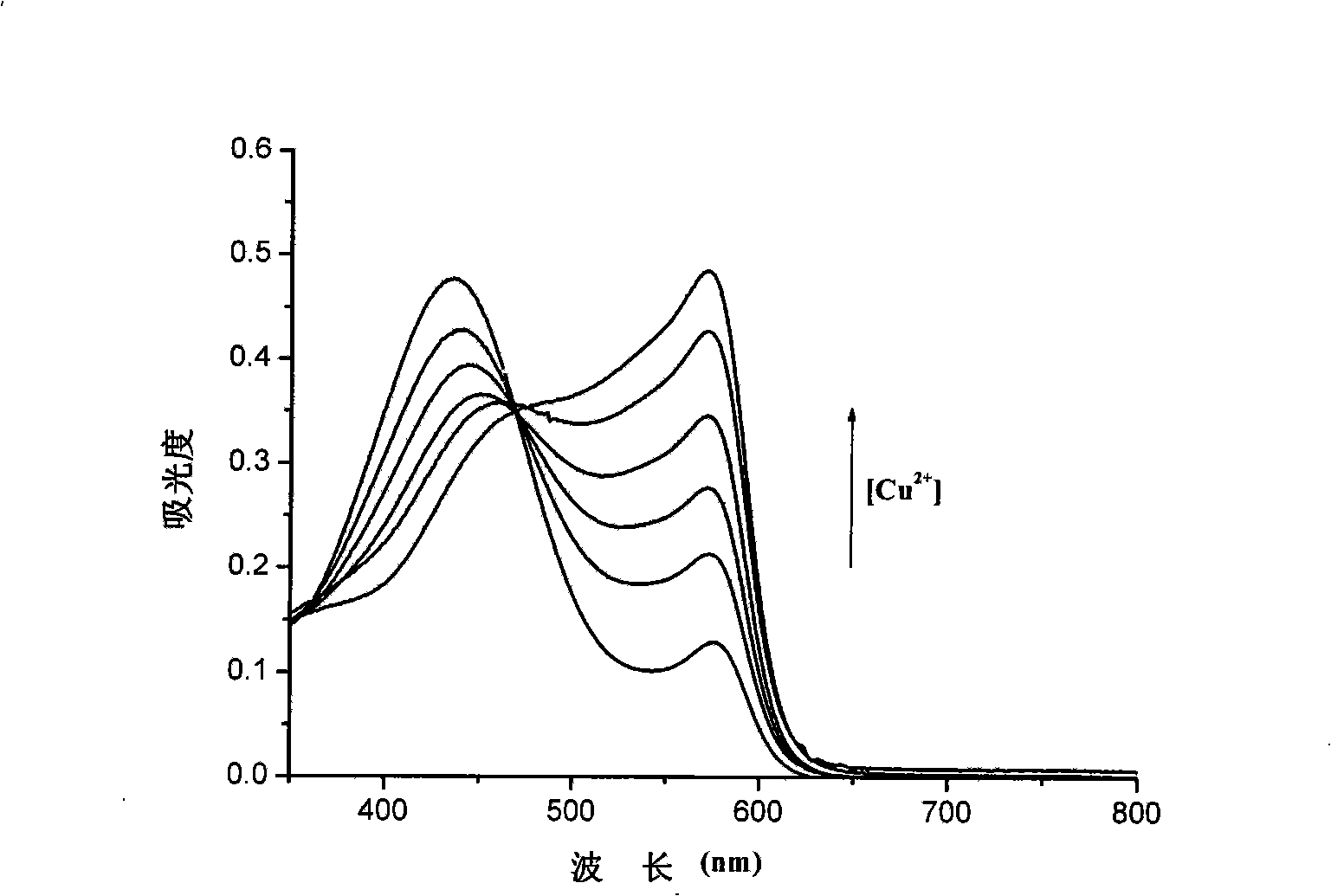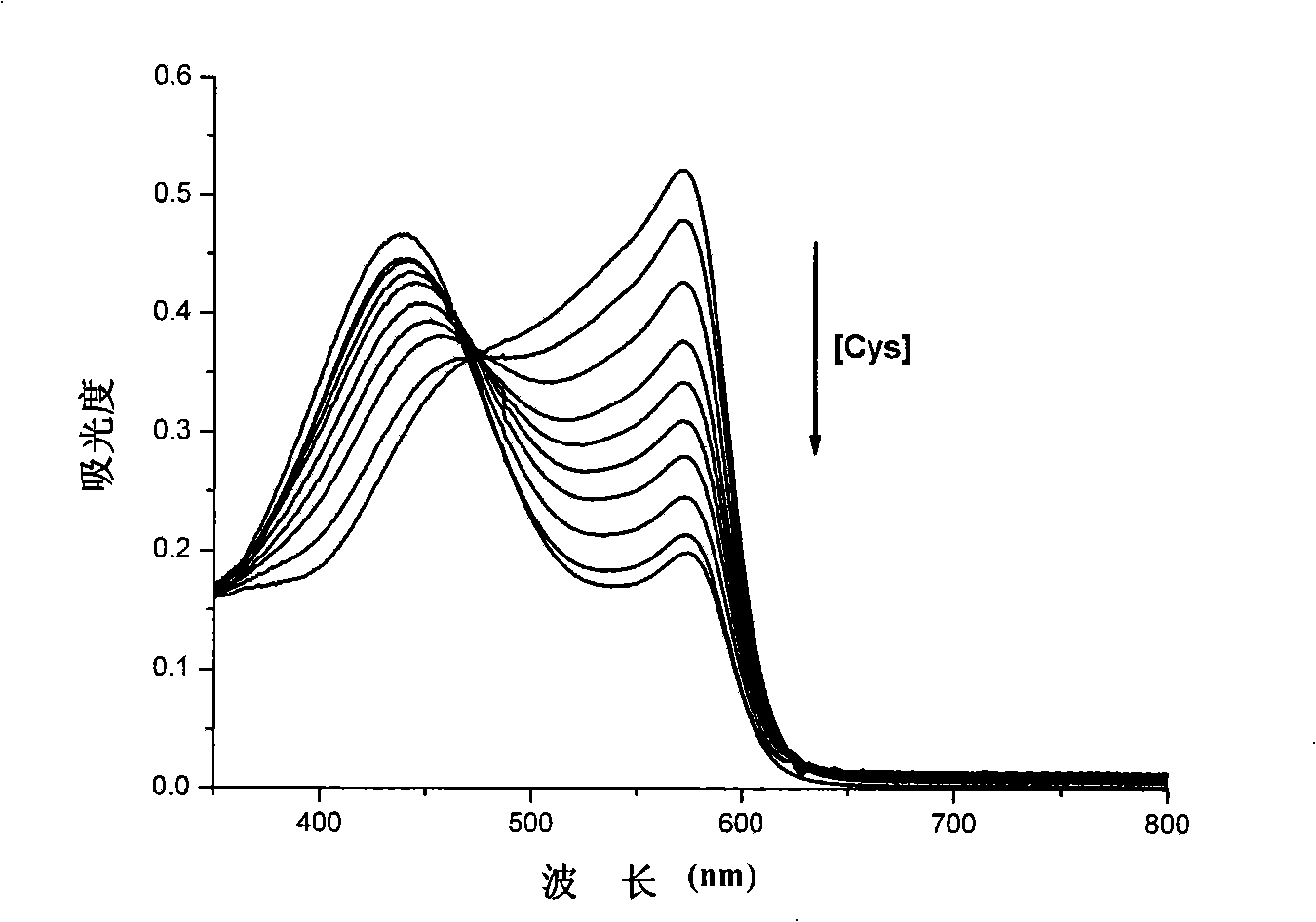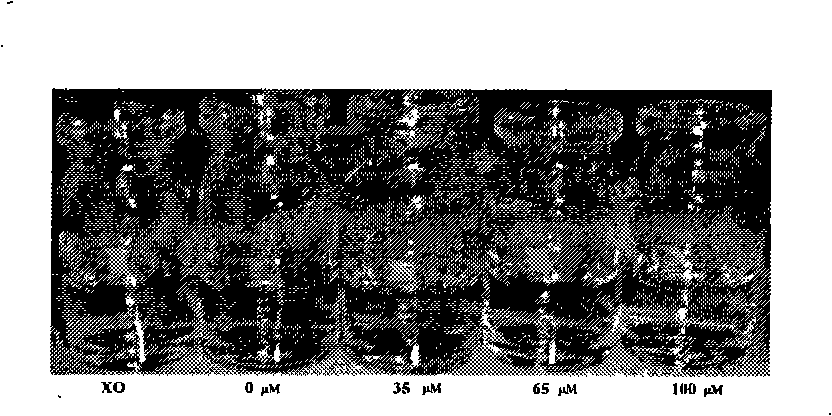Method for rapidly testing cysteine in water solution
A technology of cysteine and aqueous solution, which is applied in the field of cysteine detection, can solve the problems of inability to be fully automated, time-consuming and laborious, and limit applications, and achieve the effects of low production cost, convenient use, high sensitivity and selectivity
- Summary
- Abstract
- Description
- Claims
- Application Information
AI Technical Summary
Problems solved by technology
Method used
Image
Examples
Embodiment 1
[0050] Embodiment 1: The method for rapid detection of cysteine in aqueous solution by spectrometry
[0051] Prepare HEPES (10mM) buffered aqueous solution with pH 6.0, and prepare 2×10 -3 M copper nitrate aqueous solution, 2×10 -3 M xylenol orange aqueous solution and 2 x 10 -3 Cysteine aqueous solution of M; add 2mL of HEPES buffer solution to a clean UV cuvette as a blank, draw 2×10 -3 25 μl of xylenol orange solution of M was added to the cuvette, and the solution turned from colorless to yellow at this time, detected on a UV-visible spectrophotometer, and there was a maximum absorption at 441nm; in the above-mentioned cuvette, add 2 ×10 -3 25 μ l of copper nitrate solution of M, at this moment, the solution was changed from yellow to purple, and detected on the UV-visible spectrophotometer, it was found that the maximum absorption peak changed from the above-mentioned 441nm to 572nm, and the UV-visible absorption spectrum was shown in figure 1 Take cysteine aque...
Embodiment 2
[0052] Embodiment 2: the method for the rapid detection of cysteine in aqueous solution by solution colorimetry (kit method)
[0053] Kit preparation:
[0054] Prepare HEPES (10mM) buffered aqueous solution with pH 6.0, and prepare 2×10 -3 M copper nitrate aqueous solution, 2×10 -3 M xylenol orange aqueous solution and 2 x 10 -3 M cysteine aqueous solution; take five colorimetric tubes, respectively add 2ml of HEPES buffer solution, 25μl 2×10 -3 The xylenol orange solution of M, at this time the solution turns from colorless to yellow, denoted as R 1 , R 2 , R 3 , R 4 , R 5 ; in R 2 , R 3 , R 4 , R 5 Add 2×10 -3 M copper nitrate solution 25μl, at this time the solution changed from yellow to purple, use a micro-sampler to absorb 35μl, 65μl, 100μl cysteine and add to R 3 , R 4 , R 5 In, colorimetric visual view image 3 , R 3 , R 4 , R 5 The represented cysteine concentrations are 35 μM, 65 μM, 100 μM, respectively.
[0055] Unknown concentration cys...
Embodiment 3
[0057] Embodiment 3: the method for rapidly detecting cysteine in aqueous solution by test paper colorimetry
[0058] Prepare HEPES (10mM) buffered aqueous solution with pH 6.0, and prepare 2×10 -3 M copper nitrate aqueous solution, 2×10 -3 M xylenol orange aqueous solution and cysteine aqueous solution with concentrations of 0.01, 0.04, 0.08, and 0.1 mM; 25 μl of Cu 2+ Solution and 25 μl of xylenol orange solution were added to 2ml of HEPES (10mM) buffer solution. After stirring evenly, the solution was purple-red. Immerse a large piece of filter paper in the purple-red solution for 10 seconds, take it out and dry it in the air, and then Repeated infiltration and drying for 3 times, the cysteine test paper can be used, and the test paper is cut into strips for use;
[0059] Take 5 strips of strip test paper, soak them in the cysteine aqueous solution with a concentration of 0, 0.01, 0.04, 0.08, and 0.1mM for 3 seconds, and take them out to obtain purple (blank), pur...
PUM
 Login to View More
Login to View More Abstract
Description
Claims
Application Information
 Login to View More
Login to View More - R&D
- Intellectual Property
- Life Sciences
- Materials
- Tech Scout
- Unparalleled Data Quality
- Higher Quality Content
- 60% Fewer Hallucinations
Browse by: Latest US Patents, China's latest patents, Technical Efficacy Thesaurus, Application Domain, Technology Topic, Popular Technical Reports.
© 2025 PatSnap. All rights reserved.Legal|Privacy policy|Modern Slavery Act Transparency Statement|Sitemap|About US| Contact US: help@patsnap.com



